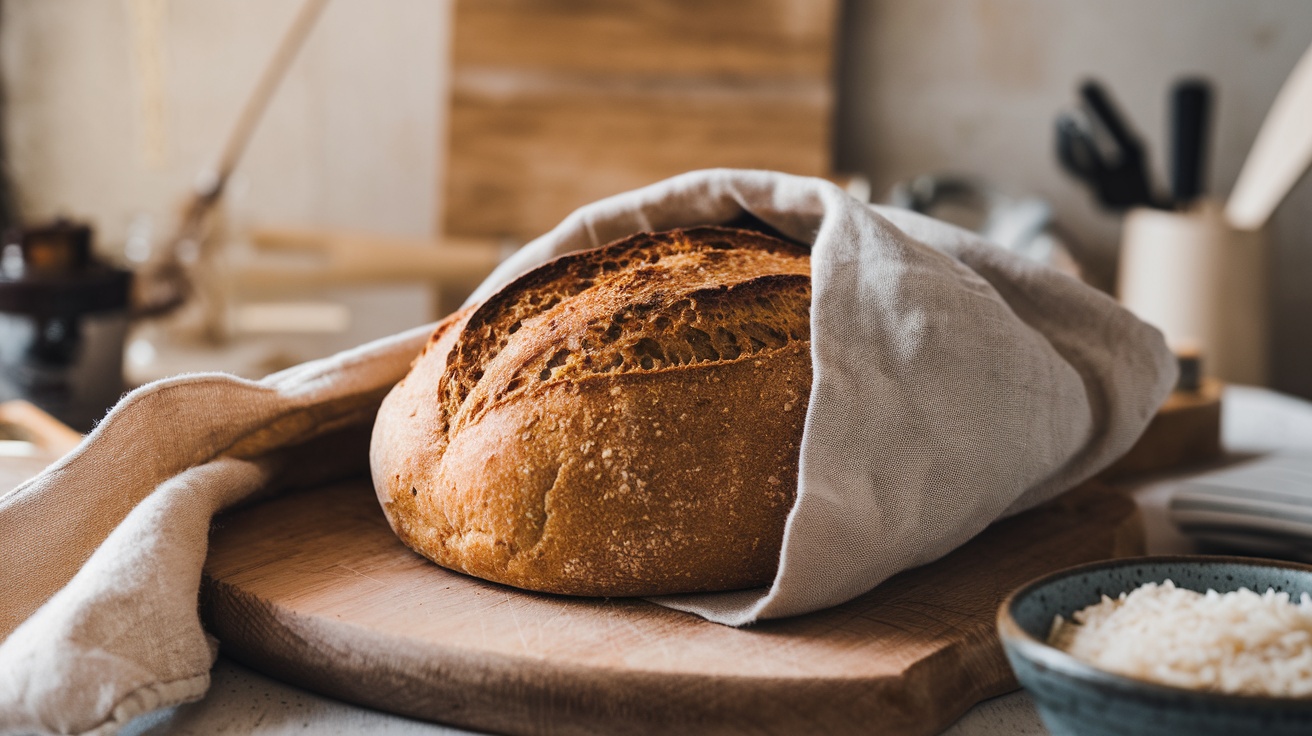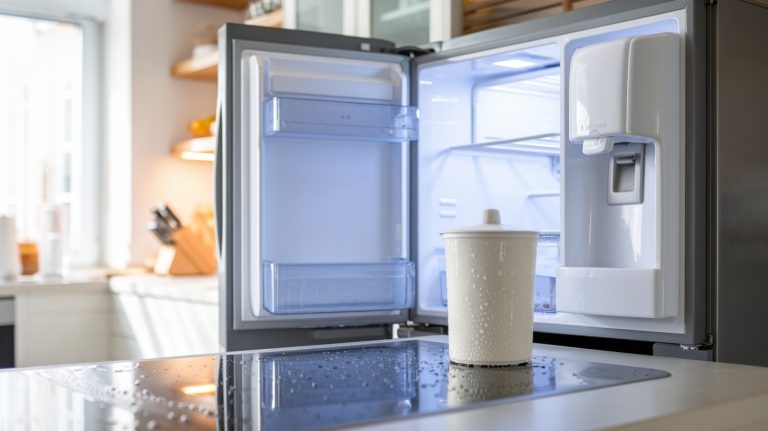How to Keep Bread from Molding? Pro Tips for Freshness
To keep bread from molding, you should store it in a cool, dry place at room temperature. Avoid plastic bags; instead, use paper bags or beeswax wraps for better air circulation.
Slice bread only as needed, and store unsliced loaves cut side down. A bread box is ideal for minimizing moisture and allowing air flow.
Regularly check for mold or staleness, and consider using sourdough, which has natural mold-inhibiting properties.
By honing these techniques, you’ll enhance your bread’s longevity and freshness. If you’re curious about other effective methods, there’s plenty more worth exploring.
Key Takeaways
- Store bread in a cool, dry place away from heat and humidity to prevent mold growth.
- Use a bread box to allow air circulation and minimize moisture buildup.
- Opt for paper bags or beeswax wraps instead of plastic bags for better breathability.
- Incorporate fats like butter or oil in the dough to slow down mold development.
- Regularly inspect bread for signs of mold or staleness and consume it promptly.
Best Bread Storage Methods
When it comes to storing bread effectively, consider these key methods to maintain freshness and prevent mold.
First, always store your bread in a cool, dry place at room temperature. A bread box that allows for air circulation is ideal, as it minimizes moisture and inhibits mold growth.
Avoid using plastic bags for bread storage; they trap moisture and accelerate spoilage. Instead, opt for paper bags or beeswax wraps to keep bread fresh.
If you have a whole loaf, slice bread only as needed, and store the unsliced loaf with the cut side down. This technique reduces exposure to air and moisture, prolonging shelf life. Regularly check your stored bread for signs of mold or staleness to guarantee quality.
If you find yourself with excess bread, you can freeze bread for later use. Wrap it tightly in plastic wrap or aluminum foil to prevent freezer burn, allowing it to remain fresh for up to three months or longer.
Ideal Places to Store Bread
Finding the ideal place to store bread is essential for maintaining its freshness and preventing mold. To effectively store bread, choose a cool place away from heat and humidity, as excess warmth accelerates mold growth.
While refrigeration might seem like a quick fix, it can cause staling unless you plan to consume the bread within 2-3 days.
A bread box is an excellent option for storage. It provides air circulation while preventing moisture buildup, reducing the risk of mold.
Additionally, keep your bread in dark storage areas like cupboards or drawers. Light exposure can promote spoilage and mold growth.
Whenever you store bread, verify it’s wrapped properly. Avoid plastic bags, as they can trap moisture; instead, opt for paper bags or cloth bags.
These materials allow for breathability, which helps maintain the bread’s ideal texture and flavor.
Effective Natural Preservation Techniques
Storing bread in the right environment is just the beginning; effective natural preservation techniques can greatly enhance its longevity.
Consider using sourdough bread, as its beneficial enzymes and bacteria actively inhibit mold growth. You can also improve freshness by incorporating fats, such as butter or oil, into your dough. These fats slow down starch retrogradation, a key factor in staleness.
When it comes to wrapping bread, beeswax wraps are an excellent choice. They provide a breathable layer that helps maintain moisture without trapping excess humidity, reducing the risk of mold.
Additionally, store your bread in a dark, cool environment, like a bread box or a cupboard, to minimize exposure to light and heat, both of which promote mold growth.
Tips for Slicing Bread Properly
Slicing bread properly is essential for preserving its freshness and preventing mold growth. To maintain ideal moisture levels, you should slice bread only as needed, ideally cutting just before consumption. If you need to pre-slice for freezing, use wax paper between the slices to prevent them from sticking together.
For sandwich loaves, always cut from the center rather than the crusty ends. This approach minimizes the exposure of the cut side to air, which helps retain moisture and prolong freshness.
After slicing, rejoin the cut halves to minimize the surface area exposed to air. This simple step greatly reduces staleness and prevents mold from developing.
When storing your sliced bread, always place the cut side down on a clean surface or against a crusty end. This technique creates a barrier against air and retains moisture longer, keeping your homemade bread fresher.
Reviving Stale Bread
Reviving stale bread can often transform it back into a delightful staple, and it’s a technique that many home cooks frequently overlook.
To effectively revive stale bread, start by dousing it with a small amount of water. This step adds much-needed moisture to both the crust and crumb, preparing it for reheating.
Next, place the moistened bread in a preheated oven set to 300°F for 10 to 20 minutes. This process helps restore the bread’s original texture and freshness.
Keep in mind that different types of bread may require tailored methods for ideal results. For instance, bread with thicker crusts might need slightly longer heating to achieve the desired crispness.
Consuming the revived bread immediately is essential, as its texture can begin to deteriorate once it cools.
Frequently Asked Questions
How Do You Keep Bread From Getting Moldy?
To keep bread from getting moldy, store it in a cool, dry place at room temperature.
Avoid plastic wraps; instead, use paper or beeswax wraps to allow for better air circulation.
If you have a bread box, it’s great for balancing humidity and ventilation.
Keep bread away from heat sources and direct sunlight, as these conditions encourage mold growth.
Regularly check for signs of spoilage and discard any affected loaves immediately.
Why Did My Bread Get Moldy so Fast?
When bread meets moisture like a ship meets stormy seas, it can quickly succumb to mold.
If your bread got moldy fast, it’s likely due to warm, humid storage conditions or improper packaging. Plastic bags can trap moisture, while storing near heat sources exacerbates the issue.
Additionally, sliced bread exposes more surface area to air, increasing spoilage risk. Regularly checking for signs of mold and consuming it promptly can help mitigate this problem.
What Is the Best Way to Keep Bread Fresh Longer?
To keep your bread fresh longer, store it in a cool, dry place at room temperature.
Use paper bags for short-term storage, as they prevent moisture buildup. A bread box is ideal, offering controlled airflow and humidity.
If you need longer storage, freeze your bread tightly wrapped in plastic or foil; it can last up to three months.
Regularly check for spoilage, consuming or discarding any bread that shows signs of aging.
Will Refrigerating Bread Keep It From Molding?
Refrigerating bread won’t effectively keep it from molding. While it might slow mold growth initially, the cold air causes the bread to lose moisture quickly, making it stale and hard within days.
Instead of refrigeration, you should store your bread in a cool, dry place, allowing for air circulation.
If mold prevention is essential, consider freezing your bread, which halts the staling process and preserves freshness for much longer.
Preserve Your Bread: Savor Every Slice with Timeless Techniques
In the grand tapestry of bread preservation, adopting the right methods can keep your loaves fresh and delightful for longer.
By choosing ideal storage spots and employing natural techniques, you can gracefully sidestep the all-too-common pitfalls of mold.
Remember, slicing with care can enhance your experience, while reviving stale bread offers a second chance at enjoying its warmth. With these strategies, you’ll savor every crumb, ensuring your bread remains a cherished staple in your kitchen.







